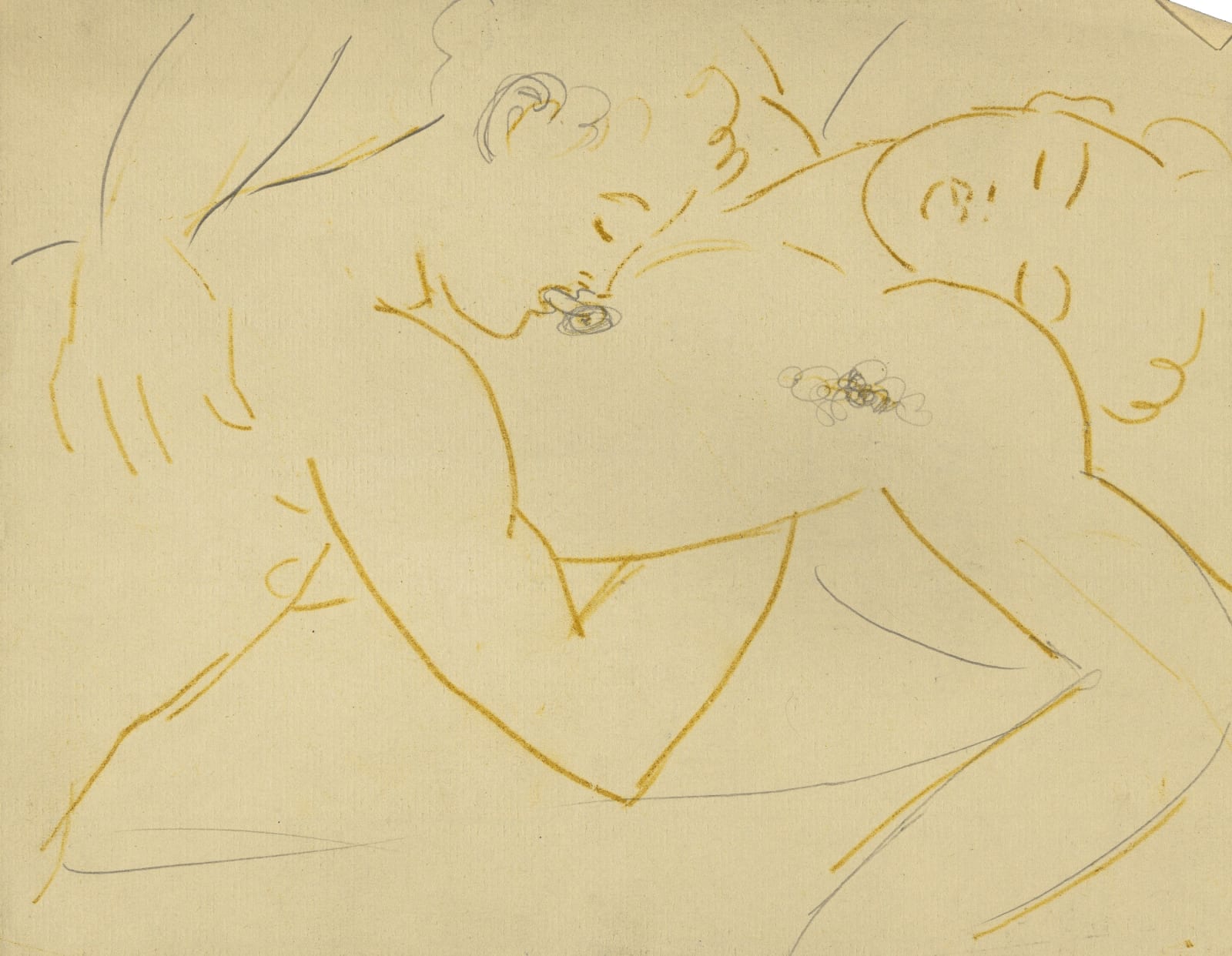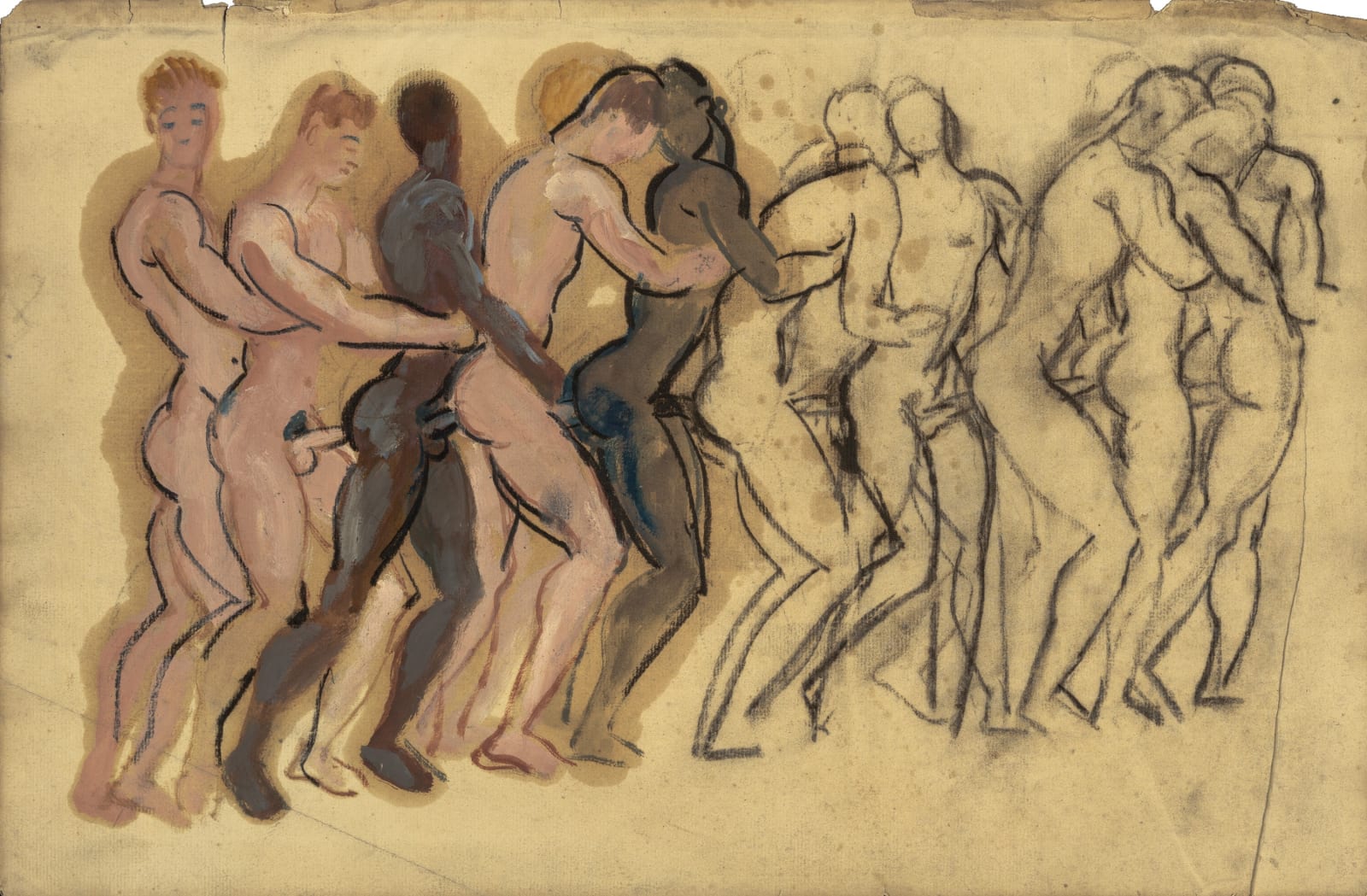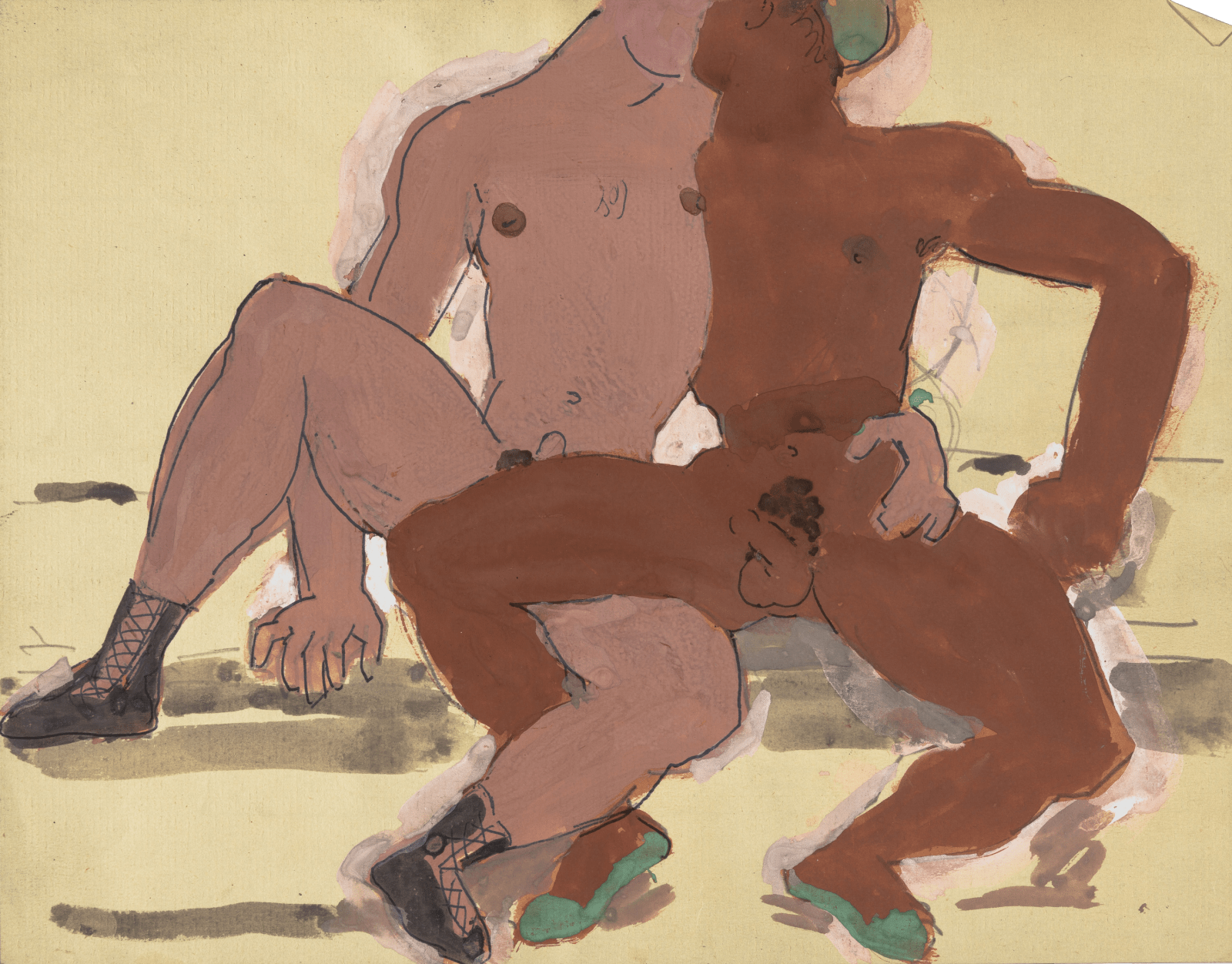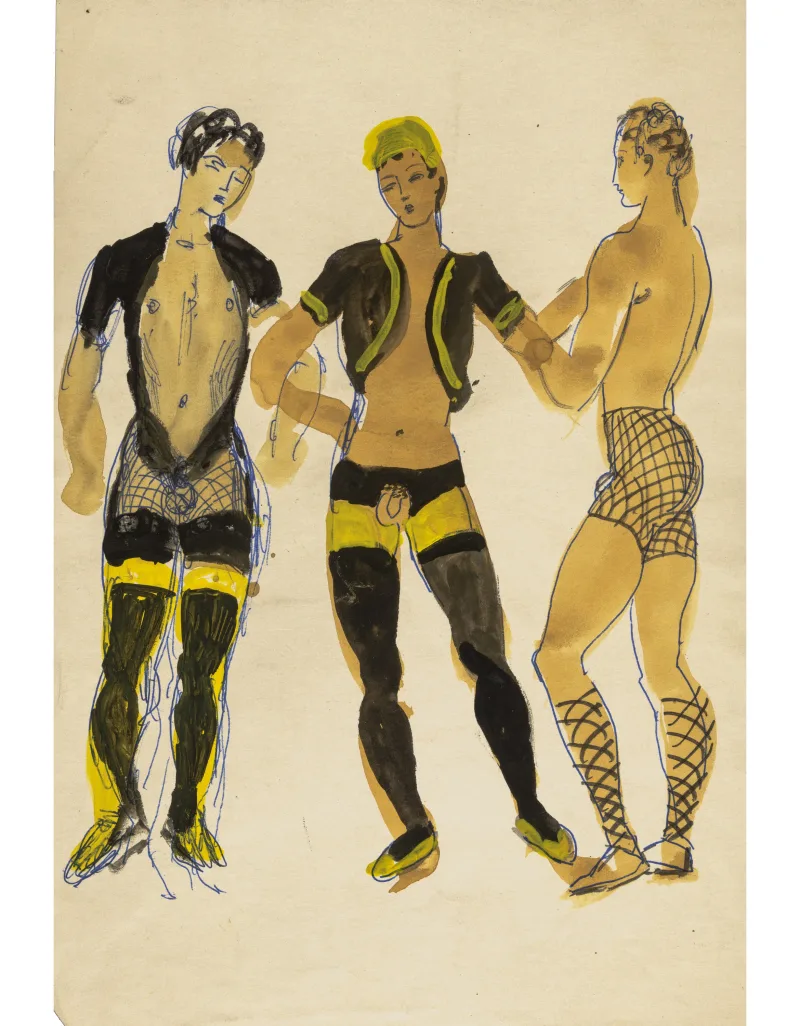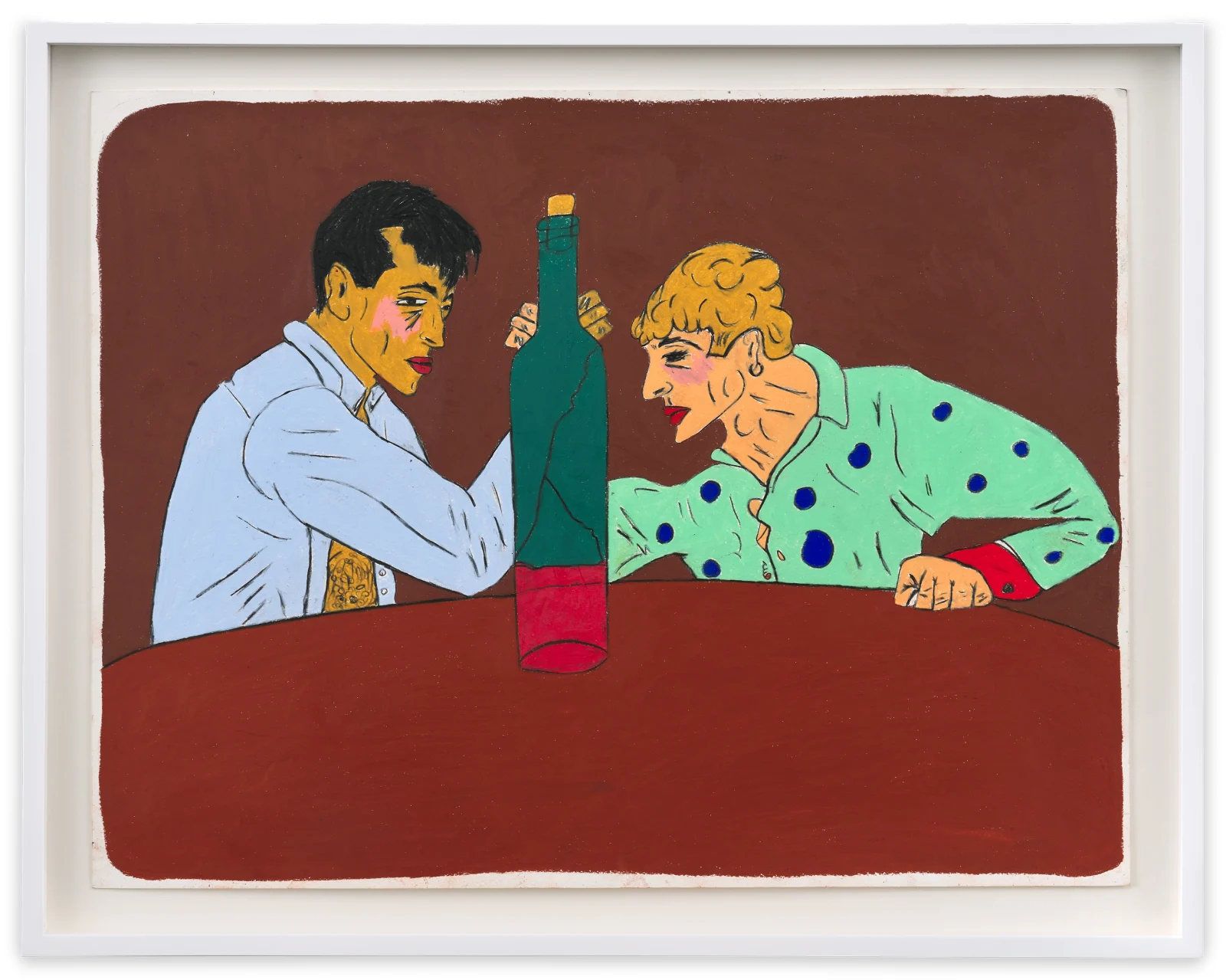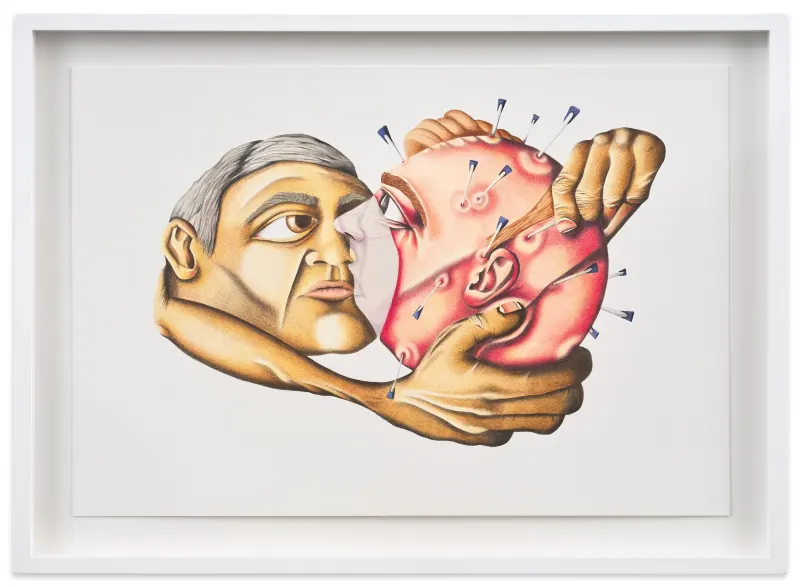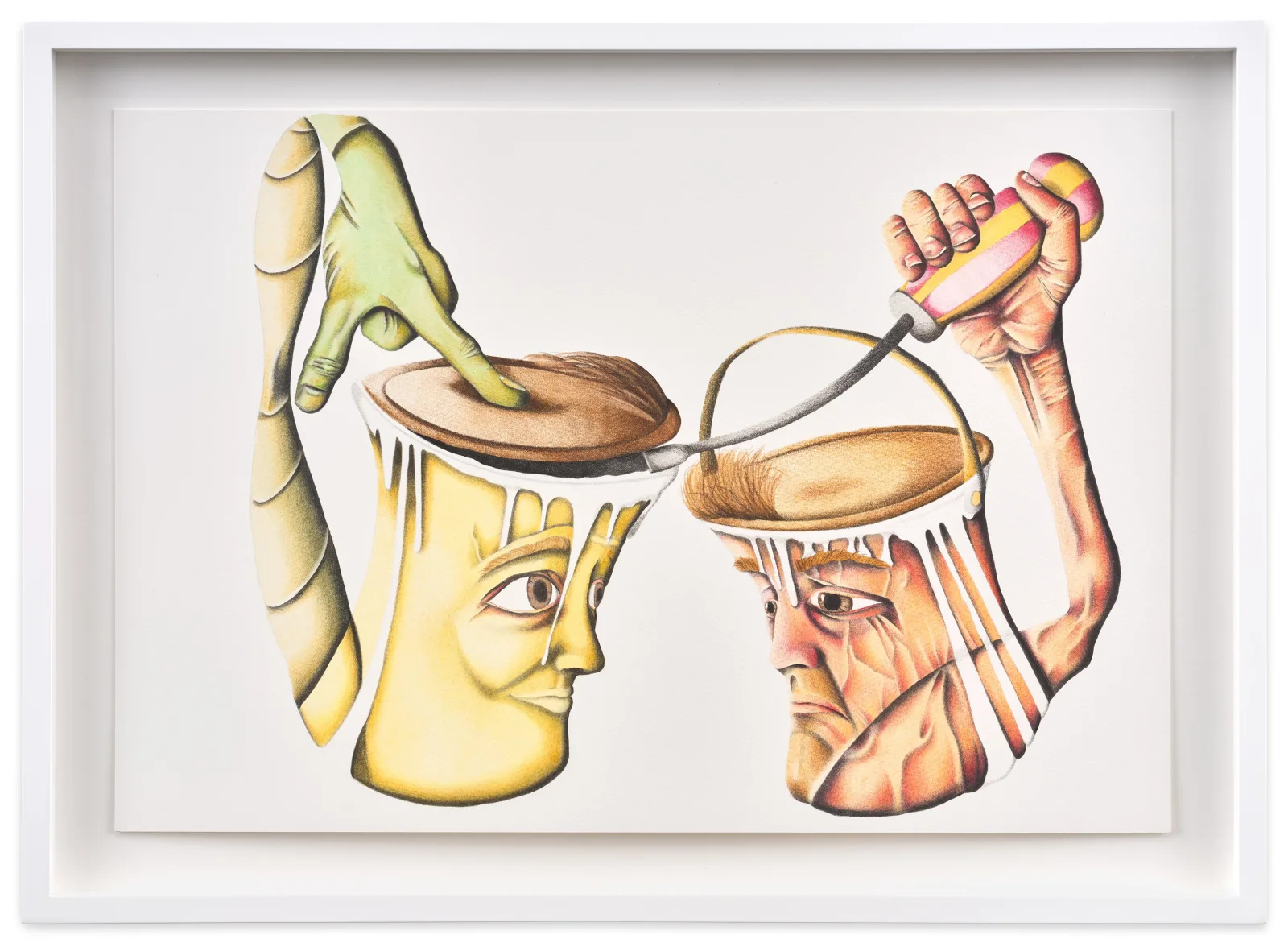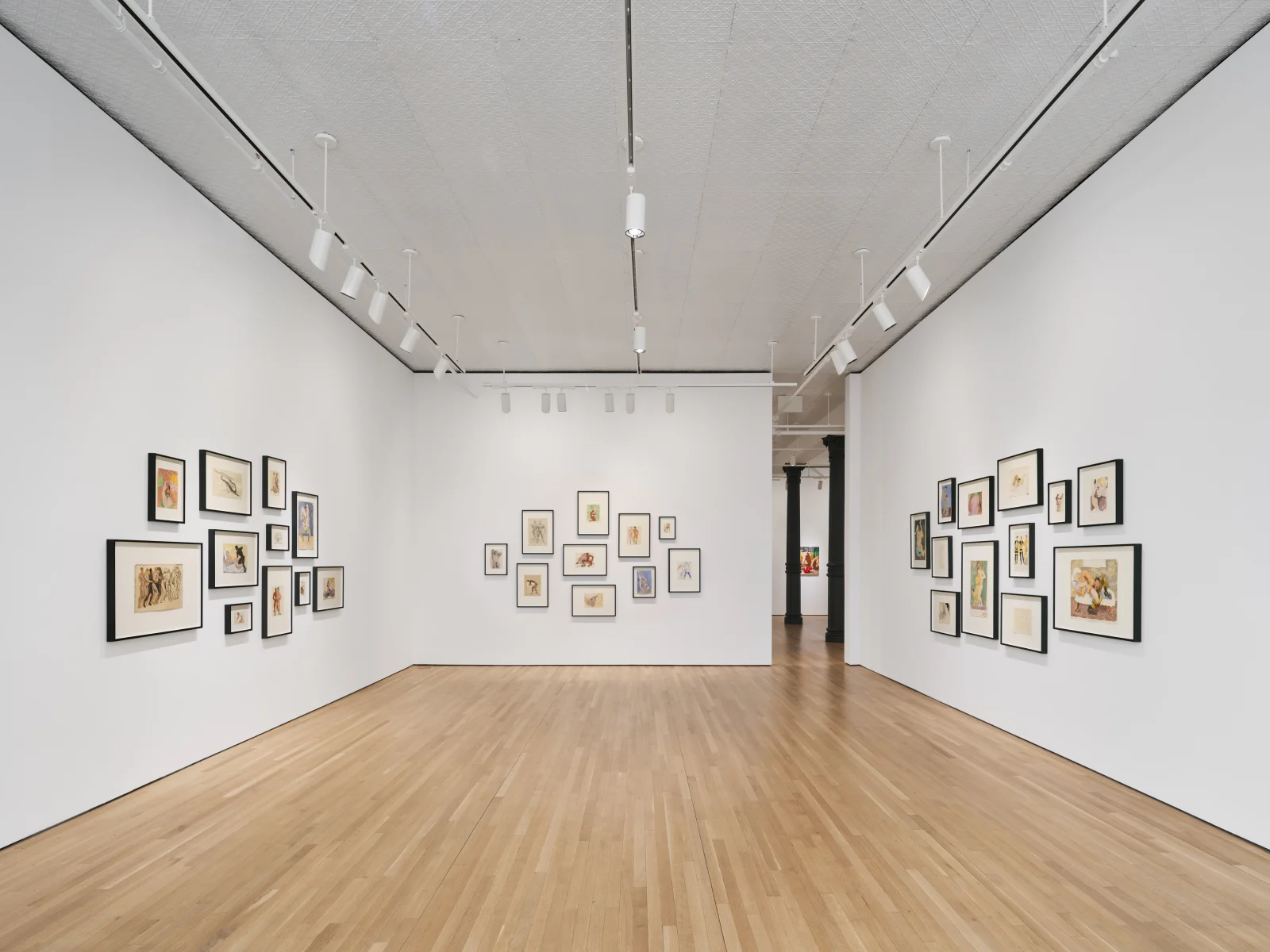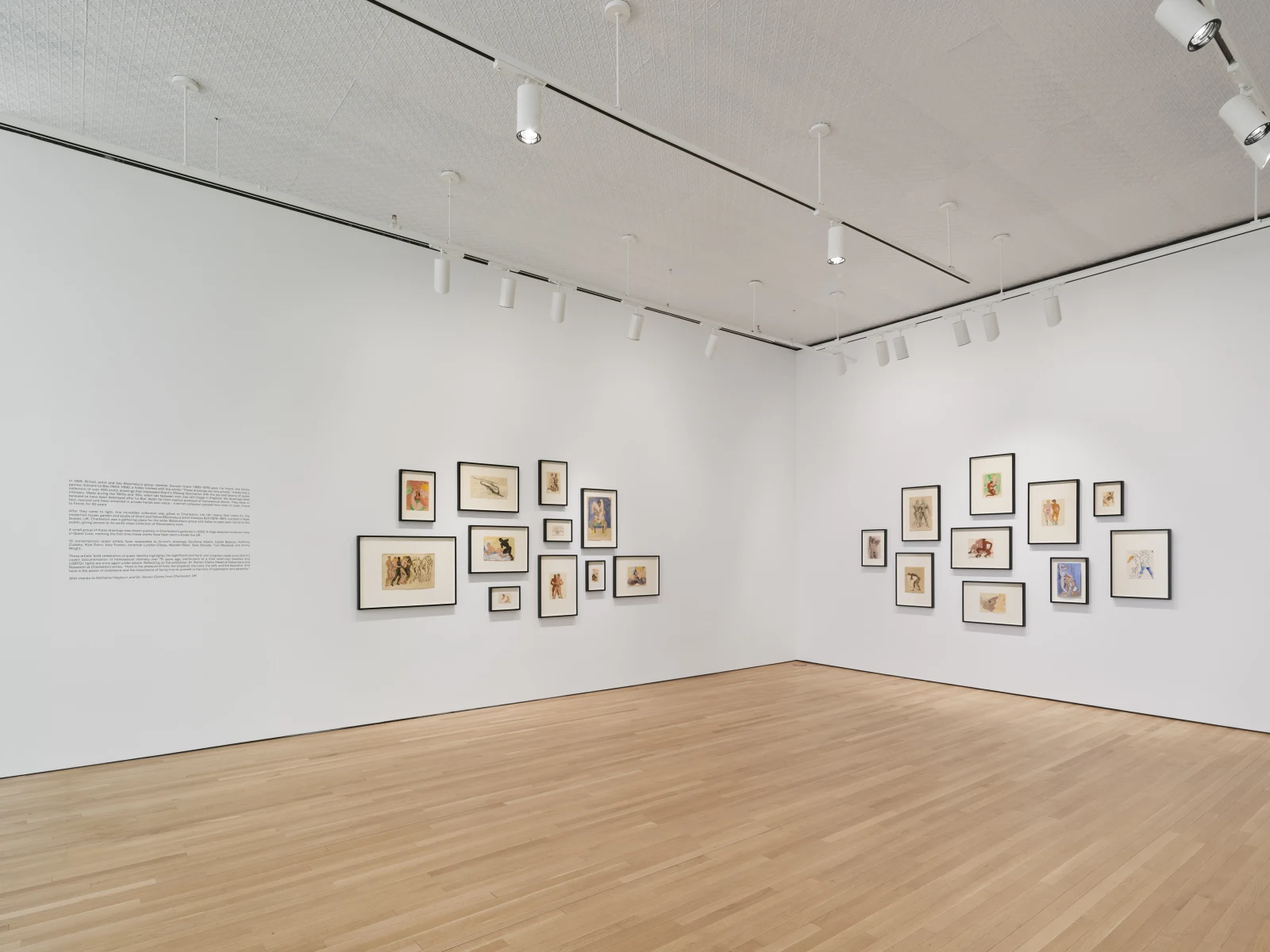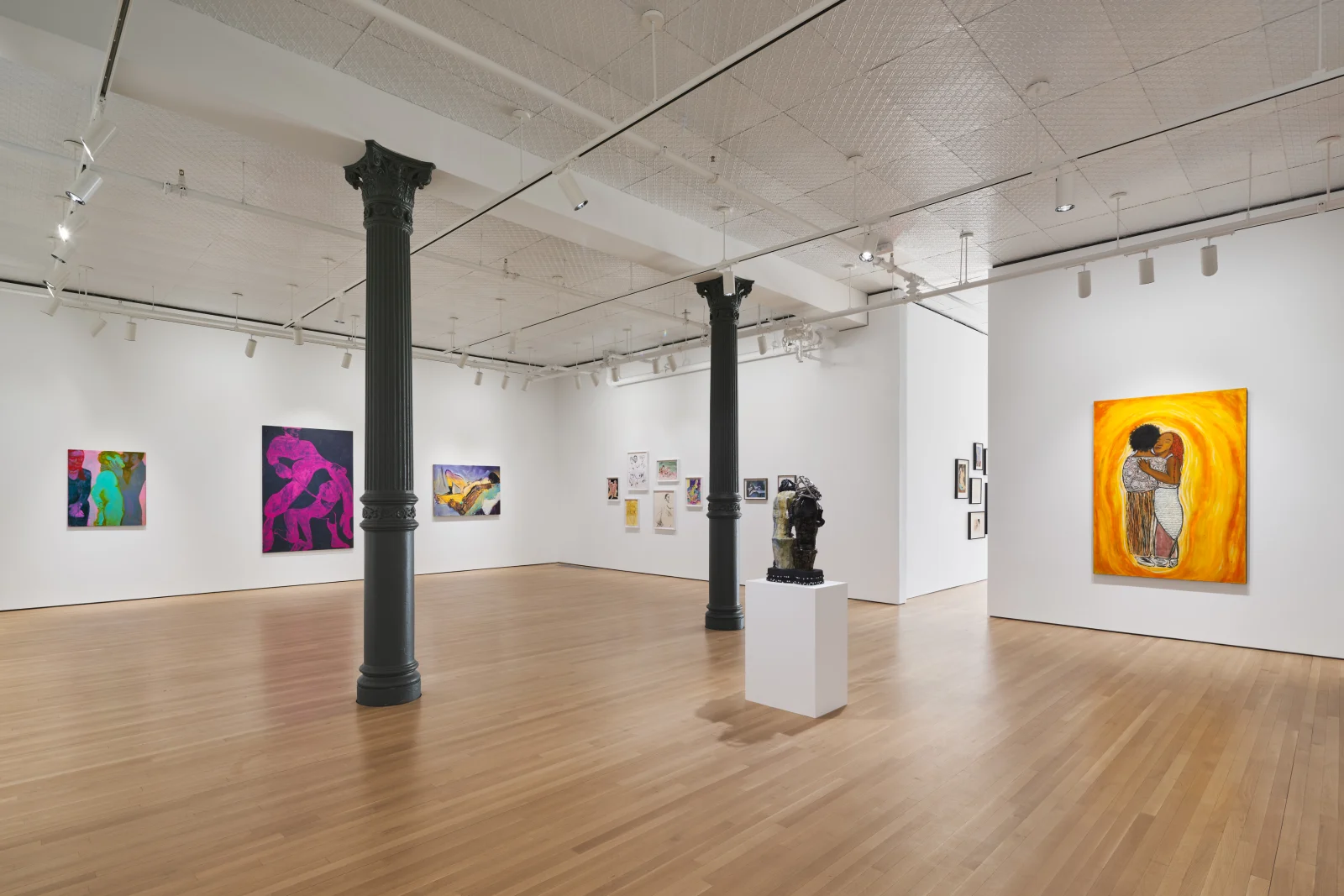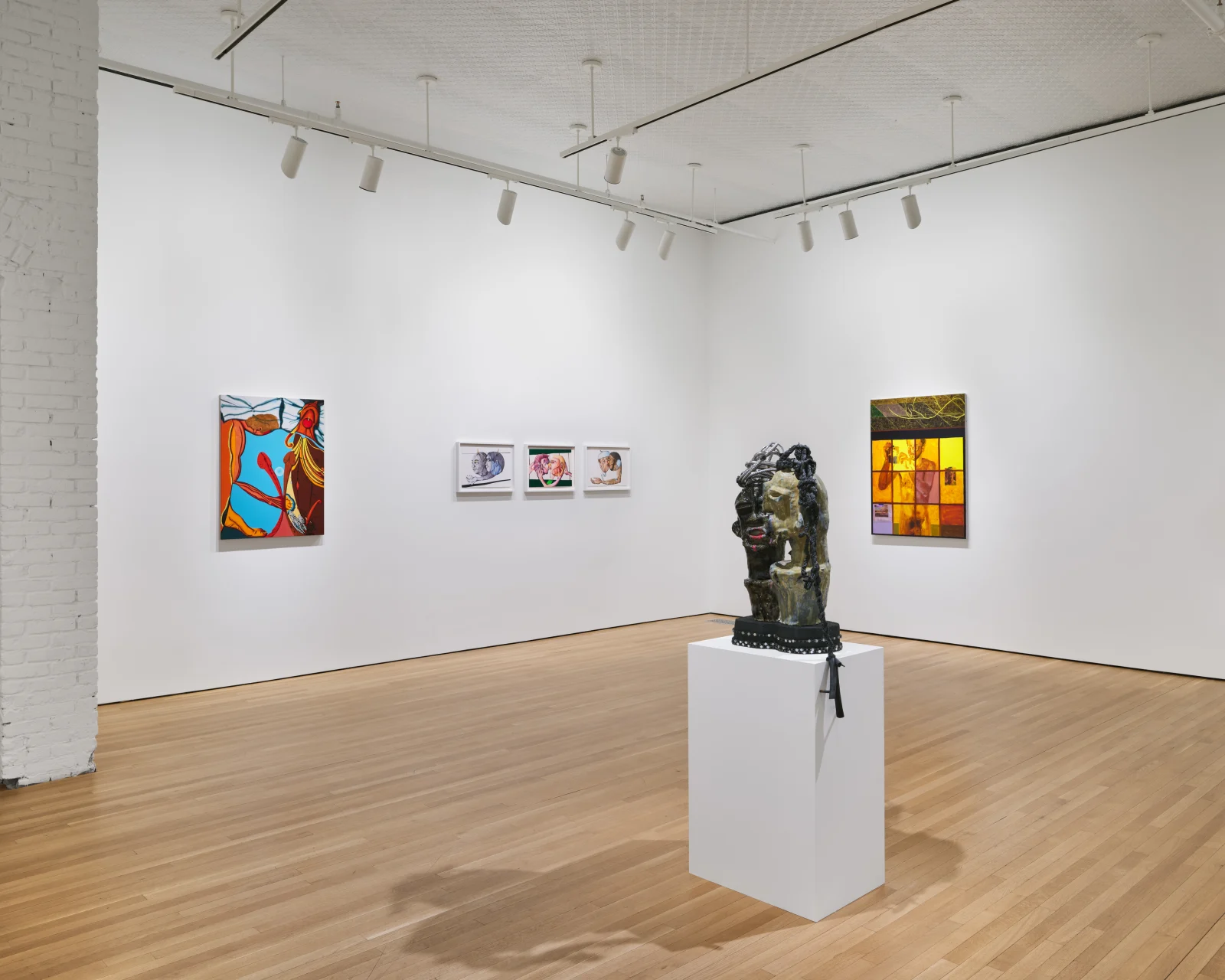Overview
Stephen Friedman Gallery presents 'Queer Love', an exhibition bringing together a selection of significant and recently discovered erotic drawings by British artist and key Bloomsbury group member Duncan Grant (1885–1978) in dialogue with new works by contemporary queer artists including: Soufiane Ababri, Leilah Babirye, Anthony Cudahy, Kyle Dunn, Alex Foxton, Jonathan Lyndon Chase, Wardell Milan, Sola Olulode, Tom Worsfold and Jimmy Wright.
The exhibition is organized in collaboration with Charleston, the UK charity that cares for the modernist house, garden and studio of Grant and fellow Bloomsbury artist Vanessa Bell (1879–1961). Located in East Sussex, UK, Charleston was a gathering place for the wider Bloomsbury group and today is open year-round to the public, giving access to its world-class collection of Bloomsbury work. Shown publicly in Charleston’s galleries in 2022, this exhibition is the first time these drawings have been seen outside the UK.
10 contemporary queer artists have responded to Grant’s works, from Leilah Babirye’s sculptural explorations of sexuality in the African LGBTQ+ community, to Sola Olulode’s tender paintings of gay love. These artists’ bold celebration of queer identity highlights the significant and hard-won progress made since Grant’s covert documentation of homosexual intimacy over 75 years ago, particularly at a time when civil liberties and LGBTQ+ rights are once again under attack. Reflecting on the exhibition, Dr Darren Clarke writes, “Here is the pleasure of love, the physical, the hard, the soft and the beautiful. And here is the power of resistance and the importance of being true to yourself in the face of oppression and adversity.”
Queer Love is accompanied by a digital booklet featuring new essays by Jack Parlett (writer, poet and author of Fire Island: Love, Loss and Liberation in an American Paradise) and Dr Darren Clarke (Head of Collections and Research at Charleston).
Stephen Friedman Gallery presents 'Queer Love', an exhibition bringing together a selection of significant and recently discovered erotic drawings by British artist and key Bloomsbury group member Duncan Grant (1885–1978) in dialogue with new works by contemporary queer artists including: Soufiane Ababri, Leilah Babirye, Anthony Cudahy, Kyle Dunn, Alex Foxton, Jonathan Lyndon Chase, Wardell Milan, Sola Olulode, Tom Worsfold and Jimmy Wright.

Duncan Grant
British artist Duncan Grant (1885–1978) was a central figure of the Bloomsbury group – a collective of artists, writers and thinkers known for their radical innovations in twentieth-century art, literature and design.
The son of Major Bartle Grant and Ethel McNeill, Duncan Grant was born in 1885 in Rothiemurchus, Inverness, Scotland. He spent his childhood in India, returning to Britain in 1893 for schooling. In 1902, Grant joined Westminster School of Art in London, where he studied for three years. Between 1906-7 he attended Jacques-Emile Blanche's school Académie de La Palette, before returning to London to study at the Slade School of Art for one term. He subsequently set up his own studio in Fitzroy Square, London.
Vanessa Bell (1879-1961) while studying at the Slade School of Art, set up the Friday Club in 1905, in which a group of artists met weekly to share ideas and support each other’s creative endeavors. It was here that Grant met Bell – their domestic and creative partnership would endure for 50 years. The Friday Club was part of a wider Bloomsbury circle, which included Grant’s cousin Lytton Strachey (1880–1932), John Maynard Keynes (1883–1946), Roger Fry (1866–1934), Virginia (1882–1941) and Leonard Woolf (1880–1969), and Vanessa Bell’s husband the critic Clive Bell (1881–1964). While the Friday Club came to an end in 1910 at a time of great change in the art world, the Bloomsbury group would continue to meet for the next thirty years. ‘On or about December, 1910, human character changed’, wrote Virginia Woolf about Roger Fry’s ground-breaking exhibition ‘Manet and the Post Impressionists'.
Grant’s legacy continues to be celebrated since his passing in 1978. Tate, UK and Charleston are collaborating on a major new exhibition, ‘Vanessa Bell & Duncan Grant’, opening at Tate Britain in November 2026.
On 2 May 1959, the artist Duncan Grant gave to his friend and fellow artist, Edward Le Bas a folder marked “These drawings are very private.” Inside were over four hundred erotic illustrations that express Grant’s lifelong fascination with the joy and beauty of queer sexual encounters. The pictures remained in private hands, a secret collection passed from lover to lover, friend to friend for 60 years.
Dr Darren Clarke (Head of Collections, Research and Exhibitions, The Charleston Trust)
They are made on all sorts of different types of paper, different sizes, and turning them over, one piece of paper after another, what appears are more than 400 images of queer sex. There are men posing on their own, in couples, in throuples and in groups. There are straight couples, and mythological scenes with satyrs and hermaphrodites. Many of the works depict interracial couples and groupings. They were made in the late 1940s and 50s, a body of work that resonates with a darker side of LGBTQ+ history in the UK when queer bodies were oppressed and outlawed, yet these works brim with joy and sensuousness.
Dr Darren Clarke
Duncan Grant was all for pornography. He said as much to one of his younger friends during a visit to New York in the late 1960s, at the age of eighty-one. The form’s simple purpose, he noted, is that “it gives pleasure.” In the erotic drawings that now bring Grant back to New York for Queer Love at Stephen Friedman Gallery, stashed away by friends for safe-keeping for many decades, a similar principle is on show. Pleasure is diffused across playful scenes of intertwined male figures, something both given and received, and never obscene. These images display a different side to Grant, the post-impressionist painter. They sit somewhere between the classicism of fine art, the casualness of everyday sketching, and the illicit thrills of erotic or pornographic material, gleefully unbothered by the distinctions between them.
Jack Parlett (writer, poet and author of Fire Island: Love, Loss and Liberation in an American Paradise)

Soufiane Ababri
Simultaneously erotic and political, Soufiane Ababri’s practice seeks to challenge violence – racial, sexual and colonial – while reconstructing the dominance of Western narratives in queer history.
Drawing is central to Ababri’s visual vocabulary, as he critically and humorously engages with art historical and literary references, including the work of Michel Foucault, Jean Genet, Félix González-Torres, Allen Ginsberg and Nazim Hikmet. In his ongoing ‘Bedwork’ series Ababri works from a horizontal plane laying down in the privacy of his bedroom. The apt title not only points to his distinct departure from a traditional studio space, but also, for the artist, operates as a marker of class division and hierarchy.
“In orientalist paintings,” Ababri says, “there were always women, Black slaves and Arabs in lying-down positions: passive, lustful, who could be controlled, not productive. They were bodies at the service of the gaze of the male painter. So I started drawing in a lying-down position, to get as far away as possible from the vocabulary of the white artist in a vertical position in his studio.” He continues: “It’s this idea of working in a domestic space, in a bed, in an intimate space, but also to do it in a position that has a sense of performance, but is effortless, in a register of laziness. Often, lying down is associated with someone who is not violent. In protests, when police arrive, people may lie down. So it’s a vocabulary of resistance.”
Soufiane Ababri was born in 1985 in Rabat, Morocco, and lives and works between Tangier, Morocco and Paris, France. He received a BA from École Supérieure des Beaux Arts de Montpellier (2010), MA from École Nationale Supérieure des Arts Décoratifs (2014) and Post-Diploma from École Supérieure des Beaux Arts (2017).

Leilah Babirye
Leilah Babirye’s multidisciplinary practice transforms everyday materials into objects that address issues surrounding identity, sexuality and human rights. The artist fled her native Uganda to New York in 2015 after being publicly outed in a local newspaper. In spring 2018 Babirye was granted asylum with support from the African Services Committee and the NYC Anti-Violence Project.
Composed of debris collected from the streets of New York, Babirye’s sculptures are woven, whittled, welded, burned and burnished. Her choice to use discarded materials in her work is intentional – the pejorative term for a gay person in the Luganda language is ‘abasiyazi’, meaning sugarcane husk. “It’s rubbish,” explains Babirye, “the part of the sugarcane you throw out.” The artist also frequently uses traditional African masks to explore the diversity of LGBTQI identities, assembling them from ceramics, metal and hand-carved wood; lustrous, painterly glazes are juxtaposed with chiselled, roughly-textured woodwork and metal objects associated with the art of blacksmithing. In a similar vein, Babirye creates loosely rendered portraits in vivid colours of members from her community.
Describing her practice, Babirye explains: “Through the act of burning, nailing and assembling, I aim to address the realities of being gay in the context of Uganda and Africa in general. Recently, my working process has been fuelled by a need to find a language to respond to the recent passing of the anti-homosexuality bill in Uganda.”
Leilah Babirye was born in 1985 in Kampala, Uganda. She studied art at Makerere University in Kampala (2007–2010) and participated in the Fire Island Artist Residency (2015). She lives and works in Brooklyn, New York.

Leilah Babiyre merges two faces in her new ceramic sculpture for the exhibition. Assembled from found objects — like many of Babiyre’s works, which address the oppression of queer people in her native Uganda — and the inner tubes of bicycle tires, this meeting of visages invokes a potent form of intimacy. Glazed in black and yellow hues, the two faces are bound together in dialogue, sharing the space of the base, without quite facing each other.
Jack Parlett

Anthony Cudahy
Exploring themes of queer identity, Anthony Cudahy’s tender compositions fuse imagery collected from photography archives, film stills, hagiographic icons, art history and his own personal photographs.
Offering vignettes into his subject’s lives, Cudahy’s paintings focus on extraordinary moments produced within everyday life. Figures are captured reading a newspaper, laying idly in wrinkled bed sheets, or passing through crowds. At once intimate and vulnerable, Cudahy’s works examine histories forgotten and untold, speaking to the cross-generational continuum of queer experience.
“A lot of significant experiences happen in quiet moments. There are entire worlds in subtle saturation or value shifts”, says the Brooklyn-based artist.
Cudahy’s first solo US museum exhibition ‘Spinneret’ opened in 2024 at Ogunquit Museum of American Art, Maine and travelled to the Green Family Art Foundation, Dallas, Texas (2024-2025). The exhibition was accompanied by comprehensive monograph on the figurative painter’s practice, featuring texts by Devon Zimmerman, Maria H. Loh and Ricardo Montez.
The artist was born in Fort Myers, Florida, USA, in 1989 and lives and works in Brooklyn, New York. He received a BFA from Pratt Institute, New York, in 2011 and completed an MFA at Hunter College, New York, in 2020.


Kyle Dunn
Inspired by cinematic lighting and melodrama, Kyle Dunn’s emotionally nuanced paintings question the ways in which public life and private selves – both physical and psychological – are entangled.
Dunn’s distinctive practice blends modernist, surrealist and classical styles, featuring elements of still life and trompe l'oeil techniques. Drawing on the perspectival play of Northern Renaissance painting, in these trompe l'oeil paintings metallic objects are illuminated and satin ribbons unfurl from drawers to guide the viewer’s eye across the composition. Dunn often propels male figures into dramatized scenes by staging his figures within highly stylized and domestic backgrounds. While some are glimpsed in quiet moments of contemplation, others are captured in scenes of languid eroticism.
“The line between work and life, public and private, can become pretty blurred”, says the artist, “they exist between the tangible things around me and my memories; on the other, they are fictionalized and exaggerated. I’m not trying to paint true or slice of life images, but I want to create emotionally resonant and truthful paintings, even if they are exaggerated.”
Kyle Dunn was born in 1990 in Livonia, Michigan, USA and lives and works in Brooklyn, New York. Originally trained in sculpture, in 2012 Dunn completed a BFA in Interdisciplinary Sculpture at Maryland Institute College of Art, Baltimore.

Alex Foxton
Deconstructing traditional archetypes of masculinity, Alex Foxton’s paintings reveal the complex interplay between historical references, identity and expression.
Foxton was born in 1980 in England, UK and he lives and works in Paris, France. Originally trained in fashion design, he graduated from Central Saint Martins College of Art and Design with a BA in Womenswear (2002) and MA in Menswear (2006). Foxton worked in fashion for twenty years, including successful stints as a designer for luxury brands Christian Dior, Bottega Venta and Louis Vuitton, before beginning a new chapter as a visual artist. “I think that wherever you start, you end up dealing with the thing you are most interested in. For me, that’s male image”, he explains.
His paintings center around the male figure, depicted in an array of physical and emotional states. Rendered in a unique combination of vibrant color and texture, his subjects are drawn from familiar figures – such as kings, soldiers, sailors and cowboys – or historical sources and mythical characters. Weaving together personal and imagined narratives, his compositions explore a sense of tenderness and terror hidden beneath his source imagery. Foxton explains: “For me, these figures stand at the crossroads between identification, fear, desire, and empathy. I think in painting them I am trying to paint myself within that system of power, and to find peace with the idea that I am not comfortable there, usually by imagining that I am subverting it.”

Some of these works appear to be influenced, like Grant’s drawings, by the more choreographed power play of kink. Alex Foxton’s Figure in a Room (2024) displays an arresting scene of carnal servitude, brightly rendered in black and pink. (These are shades touched, in queer historical terms, by the iconic black and pink designs of ACT UP posters in the 1980s.) [...] Other works return to scenes of love that strike ancient, even timeless, poses: a kiss, an embrace, or simply the act of lying together. Foxton’s Scene (2024) illuminates a passionate kiss, watched by an observer.
Jack Parlett

Jonathan Lyndon Chase
Jonathan Lyndon Chase is a Philadelphia-based artist whose interdisciplinary practice encompasses painting, drawing, video, poetry and sculpture, as they uncover the complexity of queer black subjectivity and identity.
In a 2023 interview with Jenny Gill (Director of Communications, Joan Mitchell Foundation), Chase explains: “My work is primarily about everyday experiences: what it's like being a city person, a Black person, a queer person, and also being non-binary. The body and space relationships between the private and the public are really important to me. And gender issues. I think my work is political, definitely, in relationship with different spaces and different artworks. But I'm really interested in beauty, the body at rest, showing love and tenderness in my work, and also eroticism.”
Jonathan Lyndon Chase was born in 1989 in Philadelphia, Pennsylvania, USA, where they currently live and work. Chase graduated from University of the Arts, Philadelphia, with a BFA in 2013 and completed an MFA from Pennsylvania Academy of the Fine Arts, Philadelphia, in 2016.
Jonathan Lyndon Chase’s drawings depict bodies that defy categorization, and refuse to be contained by regular forms. Faces, hands and ass cheeks melt into vibrant, brightly colored orgies. Some appear palimpsestic, like The regular time (2024). We see a threesome multiplied: translucent limbs map intersecting shades of pink, green, blue and orange, and bear the imprint of floating body parts: a pair of angry eyes, a hand holding a spliff. Some of Chase’s lines denote masculine features — a beard, chest hair, a tightly sculpted torso — but the gender of the figures is indeterminate. Other works including 3 sleepers (2024) and 7 phone numbers (2024) show bodily masses recognizable with breasts, buttocks, floating penises, organs that penetrate surrounding shapes less through force than the topsy-turvy logic of collage, at once suggestively positioned and out of place. Chase’s graphite drawing seat (2024), charts the beauty of the fat body, with rolls of flesh that form distinctive shapes as our eyes are drawn downwards, towards the buttocks, and a face consumed by the private ecstasy of ass-eating.
Jack Parlett

Wardell Milan
Wardell Milan’s multi-media works combine collage, drawing and painted elements, investigating beauty ideals, the body and the unconscious.
Conceptually rooted in photography, Milan’s compositions often reference photojournalism and news media, alongside iconic images by artists Diane Arbus, Robert Mapplethorpe, Eugene Richards and Andres Serrano. Exploring the duality between marginalization and freedom of expression, Milan imagines safe spaces where his figures can live in affirmation, intersecting sites of gender, race, sexuality and history.
Describing his practice, the artist says: “Informed by the refusal of temporality, my works on paper rely on the principles of incompletion and fragmentation. Evacuating time, culture, and the body from linear logic, these ideas and drawings become displaced and refigured in order to discover a truer, more complicated, and impossible riddled story about ourselves as individuals; and a foray for us, into self-realization, self-discovery, and perhaps a kind of socio-cultural redemption.”
Wardell Milan was born in 1977 in Knoxville, Tennessee, USA and lives and works in New York. He received a BFA in Photography and Painting from University of Tennessee (2001) and an MFA in Photography at Yale University (2004).

Wardell Milan’s Kissing on the dancefloor (2024) sketches a moment of deep connection. Milan’s kissing subjects almost seem lit from within, as in his drawing Candice and Claudia (2023), which features two naked female figures, sketched in graphite and locked in an embrace on the floor. Against a watercolor background of blues, blacks and greens, the subjects appear to glow, casting light across the room of their tryst.
Jack Parlett

Sola Olulode
British-Nigerian artist Sola Olulode’s works celebrate queer intimacies and explore embodiments of British black women and non-binary folx.
Employing an array of mediums including natural dyes, wax, ink, pastel and impasto, Olulode creates textural surfaces that echo the fluidity of identities, with a particular focus on femininity, race and belonging. Her dream-like compositions draw inspiration from lived experience, friends and cultural references, exemplifying the integral need to represent and rejoice in queer relations that transcend crude notions of queer sexuality.
Olulode’s monumental work ‘First Kiss’ (2022) is currently on view at the Hayward Gallery Billboard, UK, until April 2025. This work imagines a queer couple at the start of their romantic journey in a state of euphoria. “I’m painting things I want to see more of”, Olulode says, “I wasn’t witnessing enough stories of Black queer couples visibly happy and at peace, existing in the bubble of romance.”
Solo Olulode was born in 1996 in London, UK, where she lives and works. She completed a Foundation in Art & Design in at Chelsea Camberwell Wimbledon (CCW), University of the Arts London 2015 and BA in Fine Art Painting from the University of Brighton in 2018.
Sola Olulode depicts Black female nudes in nature, surrounded by resplendent plant life as they hold one another by the waist. In one of these works, we see a single figure, swimming through the lush green of the forest, looking ahead. She presumes the stance of the work’s title: Self-Love Is The Best Love (2025). She is alone, but not really.

Tom Worsfold
Tom Worsfold’s works explore bodies as codes; operating between humorous and uneasy reflections on the human figure.
Worsfold’s paintings and drawings are created intuitively through gradual accumulation, in a similar manner to the surrealist ‘exquisite corpse’ method. His works begin with representations of the human figure, typically isolated body parts, which are then fragmented, dissected and synthesized with everyday forms. Allowing symbolism to develop over time, the artist defines his works by states or sensations rather than narrative. By placing the body at the center of his practice, Worsfold creates a vehicle to express queer experiences and examine its currency within queer communities.
In an interview with Jane Hayes Greenwood (2019), Worsfold describes: “I think some of the humour comes from the detached way I treat bodies: the figure is presented as a ‘collection’ of surfaces and bits. Quotidian objects stand in for the self. I have always loved paintings in which bodies have an artificial, distorted look - the ‘Mannerist’ painters come to mind. In interviews, Francis Bacon describes the tension, as he sees it, between the illustrative/diagrammatic, and the felt/sensory. I am drawn to painting that straddles this same line. To me, the ubiquitous body-as-sign is curious: emojis, cartoons, safety notices, advertising, politics etc. Beginning with symbols, I probe these linguistic figures for humour, abjection, and beauty.
Tom Worsfold was born in 1990 in Cambridge, UK and lives and works in London. He received a BA from Slade School of Fine Art, London in 2013 and a Postgraduate Diploma from the Royal Academy Schools, London in 2016.
The uncanny aspects of bodily merging are also depicted, to unsettling effect, in Tom Worsfold’s paintings. Drip (2024) observes a medical scenario, between a Black man and the white face that appears in his IV drip, brought together mouth-to-mouth, floating above the arm that connects them, through veins and tubes. Crush (2024) shows a strange and kindred romance: two heads, one bruised with pink and purple, the other blonde, forced together into a kiss by several sets of floating hands. While Grant’s drawings celebrate the different forms of physical pleasure, Worsfold’s responses glimpse at the scientific, even sinister dimensions of bodily encounters, rendered as an intrusion of hands and wires.
Jack Parlett

Jimmy Wright
American artist Jimmy Wright was born in 1944 in Union City, Tennessee, and has been living and working in New York since 1974.
Upon arriving to New York, Wright documented and immersed himself in the flourishing queer subculture of nightclubs and bathhouses, post-Stonewall and pre-AIDS. Working from direct observation and personal experience, his drawings from this period evoke a similar sense of immediacy to artists Henri de Toulouse-Lautrec (1864–1901) in Paris and George Grosz (1893–1959) in Weimar Germany.
Discussing this body of work in an interview with Hyperallergic (2024), Wright says: “The sense of freedom I felt in New York had nothing to do with the art world. When I showed my drawings to other artists, people were repulsed by them, as if I were airing dirty laundry in public. So the drawings were put away. I think only one piece left the portfolio, in a trade with my good friend Roger Brown, a gay artist and Chicago Imagist. The series was first shown by Corbett vs. Dempsey Gallery in 2013.”
By the early 1980s, Wright turned his focus to paintings exploring the complexities of his American South childhood, subtly commenting on the homoeroticism of particular religious rituals. From 1988, Wright redefined his practice producing his first still lifes – a series of flower paintings on a monumental scale, characterised by thick impasto and densely textured surfaces. Made during the height of the AIDS crisis and born from a moment of profound personal loss, these works began a decades-long exploration into painting as a vessel for grief and record of time passed. Today, the artist resides in the same studio from 1979 on Freeman Alley.
Jimmy Wright completed a BFA from the School of the Art Institute of Chicago in 1967 and an MFA from Southern Illinois University in 1971.
![Jimmy Wright’s oil painting Sam Reclining (2025) [...] features a male subject (wearing, on one foot, a boot that seems...](https://artlogic-res.cloudinary.com/w_1400,h_1400,c_limit,f_webp,fl_lossy,q_auto:good/ws-stephenfriedman/usr/images/feature_panels/image/2846/wright-1.gif)
Jimmy Wright’s oil painting Sam Reclining (2025) [...] features a male subject (wearing, on one foot, a boot that seems a clear homage to Grant’s athletes), reclining in a state that could be either relaxation, or rapture. Is that another body he leans on? The golden hue of his own body resonates through the surfaces he leans on, as if he is merging with brown and teal and white and black. We may be witnessing another orgy, or simply a solo daydream, but the colorful ambiguity of Sam’s solitude reminds us that, when we enter the space of fantasy, there are always others in the room.
Jack Parlett
Bringing together diverse subjects, many of whom are neither masculine nor athletically bodied, these contemporary works look beyond stereotypical iconographies of desire, towards something queer and uncanny, a fantasia of sexual possibility. They also conjure the transformative power of gentleness, a bodily and spiritual form intrinsic to human life, described by French psychoanalyst Anne Dufourmantelle as “an occasion for sensory celebration”, and an invitation “into a sacred dance with the body of the other.” That many of these works also signal desire’s outer edges (limerence, ecstasy, violence) hints less at the fallibility of the love scenes depicted, than their proximity to extremes, a touchstone of their erotic plenitude. The line — like the piquant ballpoint animating Grant’s original drawings, those clandestine fantasies resonating across space and time — is often a fine one.
Jack Parlett




